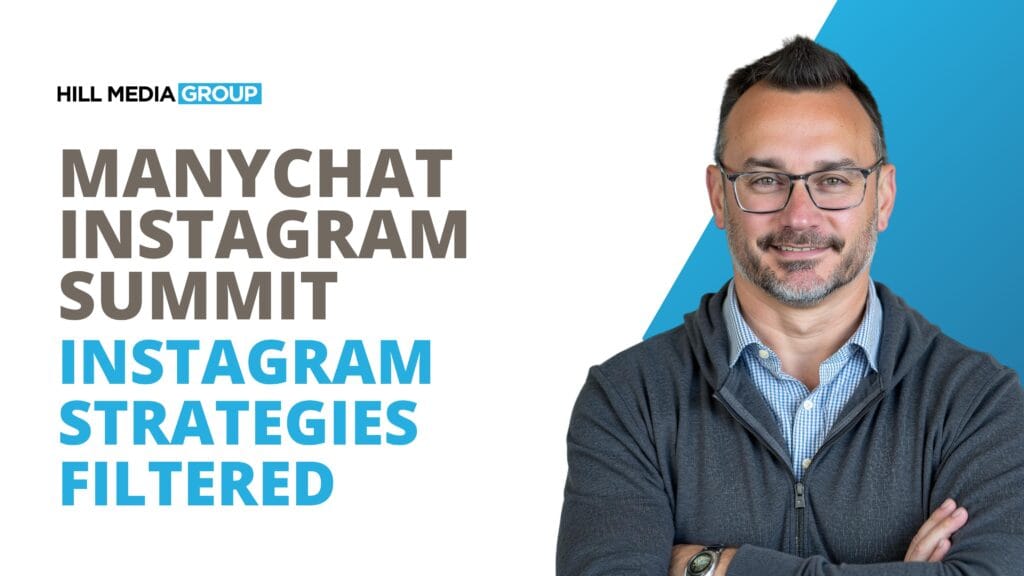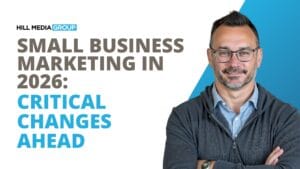A small business owner’s honest take on the Instagram Summit – separating the hype from the helpful
I spent Day 1 of the ManyChat Instagram Summit with 20,000+ creators (virtually) learning how to maximize Instagram for business growth. But here’s what I was really doing: filtering everything through one critical lens – what actually applies to small businesses?
Because let’s be real: not every Instagram strategy that works for influencers works for service businesses, online retailers, or nonprofits. And that’s the gap I want to bridge for you today.
The Summit Started With… Technical Difficulties
The event kicked off with a DJ session meant to hype up 20,000 attendees from over 100 countries. Unfortunately, the DJ’s mixer crashed mid-performance. As someone who DJ’d in my early 20s, I felt that pain – nothing kills the vibe faster than technical issues when you’re trying to create energy.
But here’s the interesting parallel: this technical hiccup mirrors what small businesses face every day. You plan everything perfectly, and then something breaks. The difference between success and failure isn’t avoiding problems – it’s having systems that keep working even when things go wrong.
ManyChat’s Big Announcements: What Actually Matters
ManyChat CEO Mikhail Yan shared some impressive numbers:
- Over 1 million Instagram accounts now connected to ManyChat
- 5 billion conversations powered in the last 12 months
- The creator economy projected to grow from $200B to $500B in just 5 years
What this means for small businesses: Instagram automation isn’t just for influencers anymore. It’s becoming infrastructure – like having a website or an email list. The question isn’t whether to use it, but how to use it without turning your Instagram into a sales bot.
The New Features Coming in 2025
ManyChat announced several new tools, but only two caught my attention as genuinely useful for small businesses:
1. Inbox Labels (powered by AI) Think of this as Gmail filters for your DMs. The AI automatically sorts conversations into categories:
- Hot leads (people showing buying intent)
- Partnerships
- Super fans
- Friends and family
- Spam
Why this matters: If you’re a service business owner juggling customer inquiries, partnership opportunities, and spam all in one inbox, this could save you hours every week. The “hot leads” filter alone could prevent you from losing customers because their message got buried.
2. Scheduled Messages 2.0 You can now schedule follow-up messages that automatically cancel if someone responds first.
Why this matters: For service businesses, this is gold. Schedule a “Hey, did you still need that quote?” message for 48 hours from now, but if they respond first, it won’t send. No more awkward double-messages or manually tracking who you need to follow up with.
The Sessions That Actually Delivered Value
Megan Hall: Finding Real Pain Points (Not Surface Problems)
Megan Hall built a seven-figure business in 2.5 years starting from zero, and her session on audience research was the most immediately actionable content of the day.
Her core insight: Stop asking “What do people want?” and start asking “What keeps them up at night?”
She shared eight AI prompts to dig deeper into customer psychology. Instead of surface-level problems like “I need more followers,” her method uncovers the real emotional drivers: “I feel like a failure because I’ve been posting for a year and still haven’t made a sale.”
Why service businesses should care: Think about your local HVAC company, restaurant, or medical practice. Your customers don’t just want their AC fixed – they’re worried about expensive repairs, uncomfortable sleeping conditions, and looking irresponsible in front of their family. Understanding that emotional layer changes how you communicate.
The translation for small businesses:
- Service businesses: Your customers aren’t just looking for a service provider – they’re looking for someone who understands their stress and urgency
- Online businesses: Your buyers aren’t just shopping – they’re trying to solve a problem that’s been frustrating them
- Nonprofits: Your donors aren’t just giving money – they want to feel connected to meaningful impact
Jun Yuh: The Content System for Busy Business Owners
This was the session I was waiting for. Jun Yuh built a 5-million-follower empire, landed a Red Bull partnership, and made his first million – all while completing dual engineering degrees. His secret? A phone-based content system that works in 15-30 minute blocks.
His three-part framework:
- Become the niche (don’t just pick a niche)
- Choose the right format (stop reinventing the wheel)
- Build a phone content system (batch everything)
The game-changer for small businesses: His “scene library” concept. Spend one hour filming B-roll of common scenarios (working at your desk, making coffee, walking outside, talking on the phone), organize them into labeled albums on your phone, and you suddenly have a month’s worth of content ready to go.
Why this works for small business owners:
- You don’t need a film crew
- You don’t need expensive equipment
- You don’t need hours every day
- You just need one focused filming session and smart organization
His “three-take rule” is also brilliant: give yourself three tries per line, then move on. Most creators waste hours trying to perfect one clip. Jun’s method keeps you moving and prevents burnout.
Grace Andrews: Content Creator vs. Influencer (And Why It Matters)
Grace made a distinction I wish more small business owners understood: There’s a massive difference between being an influencer and being a content creator.
Influencers build audiences to influence purchasing decisions – often through partnerships and sponsorships. Content creators build audiences to provide value and educate – monetizing through their own products, services, or expertise.
Why this distinction matters for your business:
- You’re not trying to become an influencer
- You’re not trying to “go viral” for vanity metrics
- You’re trying to be a content creator who educates potential customers and builds trust
Grace’s philosophy: “Your job isn’t to go viral. Your job is to speak so clearly to your audience that they never forget who you are.”
This aligns perfectly with our education-first approach at Hill Media Group. We’re not here to help you chase viral trends – we’re here to help you create consistent, valuable content that builds long-term customer relationships.
The Affiliate Marketing Master Class (That Most Small Businesses Will Skip)
Janesha Moore shared how she generates $40,000+ monthly through affiliate marketing. Her journey from being laid off in 2023 to making $100,000 in six months was impressive, but here’s my honest take:
This strategy works brilliantly for fashion/lifestyle content creators. If you’re building an audience around style, products, and recommendations, affiliate marketing can be incredibly lucrative.
But it’s not the right primary strategy for most service businesses, restaurants, or nonprofits. You’re not here to recommend other people’s products – you’re here to sell your own services and build your own customer base.
That said, there was one golden nugget: She uses her affiliate data to pitch brands for partnerships. By showing a brand exactly how much revenue she’s driven for them organically, she’s able to negotiate paid partnerships. That’s smart business.
The Sessions I Found Less Useful (Being Honest)
Gabby Windey Interview
The session title was “Winning fans everywhere they scroll,” but I walked away with almost no actionable insights. Gabby spent most of the time discussing her personal journey around sexuality rather than providing tactical strategies for winning fans across platforms.
For a summit aimed at helping businesses grow on Instagram, this felt like a missed opportunity. Sometimes celebrity interviews sound great on paper but don’t deliver the practical value small business owners need.
The Launch-in-24-Hours Pitch
Abigail Pumphrey from Teachable delivered a presentation on launching digital products in 24 hours. While her framework was solid (pressing problem test, quick win test, no-brainer pricing test), the presentation felt more like a Teachable sales pitch than a value-driven session.
The useful concept: Think of your customer journey as stages, and create offers that solve problems at each stage. An entry offer solves the problem that has to be solved before your signature offer makes sense.
The reality: Most small businesses aren’t digital product businesses. You’re service providers, retailers, restaurants, or nonprofits. While the concept of understanding customer journey stages is valuable, you don’t need a “one-day launch challenge” – you need a solid website, consistent marketing, and systems that nurture leads into customers.
The Viral Video Strategies That Actually Work
Sarah Snow: Authenticity Beats Production Value
Sarah generated over 100,000 leads with viral videos across four different industries. Her big revelation? She started as an artist who hated traditional marketing, avoided terms like “funnels” and “leads,” and only succeeded when she stopped trying to monetize first and started creating authentic content.
Her six rules for viral creating:
- Pre-production: Start a daily writing practice (even 5 minutes)
- Camera confidence: Use the “five sentences back” method (start before your script to sound more natural)
- Technical: Start where you are and learn one thing each time
- Quantity: Focus on loving the process
- Consistency: One intentional video per week beats daily low-quality content
- Being known: Send videos to yourself daily to practice
The lesson for small businesses: You don’t need perfect production. You need authentic stories that resonate. That restaurant sharing behind-the-scenes prep work, that auto shop explaining common repair mistakes, that nonprofit showing real community impact – that’s the content that builds trust.
Conar Fair: The $2.4 Million Ad (Broken Down)
Conar Fair from One Peak Creative shared the exact video ad that generated $2.4 million in revenue for his digital course business. It was shot on an iPhone in 4 hours.
The seven-element formula:
- Hook – Stop the scroll in first 3 seconds
- Credibility shift – “You’re probably thinking who does this guy think he is? But…”
- Story arc – Relatable beginning, transformation middle, success end
- Proof – Specific results and numbers
- Pain points – Address objections before they arise
- Transformation – Show what success looks like
- Clear CTA – Tell them exactly what to do next
The unofficial 8th element: Relatability. Pop culture references, memes, shared experiences – anything that makes viewers think “they get me.”
Translation for service businesses: “If you’ve been calling around trying to find an honest mechanic, listen close. You’re probably thinking ‘great, another shop trying to upsell me stuff I don’t need.’ But I get it – I was on the other side of the counter for 15 years before opening my own shop. Here’s what actually happened when I took over this business…”
Colin & Samir: Five Ways to Build a Creator Brand That Lasts
Colin & Samir, who have spent a decade teaching sustainable creator growth, shared five principles for longevity:
- Know your why – Beyond making money or going viral
- Build a personal brand – Not just follower count
- Create trust – The currency that matters most
- Diversify your platforms – Don’t rely on one algorithm
- Stay authentic – Consistency in values matters more than consistency in posting
Why this matters: They reinforced what Lauren Berty said earlier – a thousand ride-or-die fans beats a million casual viewers every single time.
Lauren Berty: From Viral Moment to Sustainable Business
Lauren’s talk was refreshingly honest. She started creating content during COVID out of fear and loneliness after becoming pregnant with twins. One vulnerable video about unrequited love got 1.4 million views and 17,000 new followers.
But here’s what she emphasized: It wasn’t the viral video that built her business. It was the community that stayed.
Her podcast has a 60% conversion rate on anything she asks her audience to do. Her Instagram? Maybe 2%. The difference? The podcast built deep trust through long-form conversations.
The lesson for small businesses: Quick wins on social media feel good, but sustainable business comes from building real relationships. That might be through email, through community events, through consistent helpful content – whatever builds trust over time.
What I’m Taking Forward (And What I’m Leaving Behind)
What’s Actually Useful for Small Businesses:
1. Inbox organization matters. If you’re managing customer inquiries through Instagram DMs, the new AI-powered labels could save you hours and prevent lost opportunities.
2. Content doesn’t need to be perfect. Jun Yuh’s phone-based system proves you don’t need expensive equipment or a production crew. You need organization and consistency.
3. Authenticity beats polish. Sarah Snow and Lauren Berty both built multi-million dollar businesses by being vulnerable and real, not by having perfect aesthetic feeds.
4. Pain-point research is crucial. Megan Hall’s AI prompts for understanding deeper customer psychology are worth implementing regardless of your business type.
5. The content creator vs. influencer distinction matters. You’re not trying to become an influencer. You’re trying to educate and build trust with potential customers.
What I’m Skeptical About:
1. The constant push for automation. Yes, automation can help. But be careful not to let your Instagram presence feel robotic. The tools should enhance human connection, not replace it.
2. The “anyone can launch in 24 hours” narrative. While quick validation is valuable, sustainable business still requires proper systems, quality, and long-term thinking. Don’t let urgency push you into launching something half-baked.
3. The heavy emphasis on video ads. Conar’s results are impressive, but running paid ads requires budget, expertise, and willingness to test and iterate. For most small businesses, organic content + email marketing + local SEO will deliver better ROI than diving headfirst into paid video ads.
What’s Coming on Day 2
Tomorrow’s lineup includes:
- Zach King on mastering the magic of social media
- Austin Schneider on ads, automation, and authority
- Evita Barwise on growth hacks that work
- and much more…
I’m particularly interested in Zach King’s session since he’s mastered the art of creating scroll-stopping content that’s both entertaining and strategic.
The Bottom Line for Small Business Owners
If you’re a service business, online retailer, restaurant, or nonprofit, here’s what you should actually do after reading this recap:
Don’t try to implement everything. Pick one thing:
For service businesses (HVAC, auto repair, landscaping, etc.):
- Implement inbox labels when they launch to better manage customer inquiries
- Use Jun Yuh’s scene library concept to batch-film common scenarios once a month
- Focus on educational content that addresses customer fears and frustrations
For online businesses:
- Apply Megan Hall’s pain-point research to understand what’s really stopping purchases
- Create one authentic video per week using Sarah Snow’s six rules
- Build an email list that actually nurtures leads (Instagram alone isn’t enough)
For nonprofits and churches:
- Focus on storytelling that shows impact (like Sarah Snow’s authentic approach)
- Use video to make your mission tangible and relatable
- Build a podcast or consistent content series to deepen donor relationships
For everyone: Remember Grace Andrews’ wisdom: Your job isn’t to go viral. Your job is to speak so clearly to your audience that they never forget who you are.
Want More Insights Like This?
I’m attending Day 2 tomorrow and will break down the most useful takeaways for small businesses.
Subscribe to my newsletter to get the Day 2 recap plus ongoing marketing insights filtered specifically for businesses like yours – where we focus on education first, sustainable growth, and strategies that actually fit your budget and bandwidth.
Subscribe to the Marketing Mindset Monday Newsletter
Because you don’t need to be an influencer. You just need to be consistent, authentic, and helpful to your customers.
About the Author: Jerad Hill is the founder of Hill Media Group, a digital marketing company focused on helping small businesses transform their online presence through education-first strategies. Unlike most marketing agencies that push tactics, we teach principles – so you understand not just what to do, but why it works.




